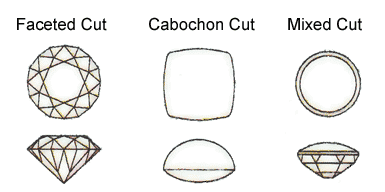When a raw gemstone is deemed valuable for use in jewelry it is cut to maximize its natural color and light reflective properties. Cutting diamonds is different from cutting other precious stones. While diamonds are the hardest substance naturally found on Earth, usually they are white or uniformly colored. Hence, cutting diamonds most often involves ensuring brilliance of the stone. Colored gemstones tend not to have uniform color and/or light diffusion properties. Hence, cutting precious gems involves ensuring uniform color and acceptable number of inclusions. There is no universal system of gemstone cuts despite attempts to create such. However, it is possible to differentiate types and shapes of most common cuts.
Types of Cuts:
Visual examination of precious and semi-precious stones usually reveals one of three major types of cuts. They are faceted gems, non-faceted smooth polished gems, and mixed cut/polish.

Faceted cuts:
Faceted cut owns its look due to multiple small polished surfaces. It is most often used for transparent stones. Most types of faceted cuts can be combined into three categories. They are: brilliant, rose, and angular step cuts.
Brilliant cut comes in a number of shapes, most notable being the Round Brilliant Cut also knows as American Standard Cut. The cut is believed to have been originated by Vincenzo Peruzzi in the 18th century. It was developed and refined for Diamonds, but today is commonly used for all gems. Round cut stones vary, but the standard number of facets is 57. The cut has one of the best recoveries for Diamond rough (greatest amount of gem quality diamonds produced from rough stone with minimal material loss) and provides the best optics for brilliance and scintillation, giving gems that effervescent sparkle with light.
Other popular shapes of faceted cuts are oval, pear, marquise, and antique cushion cut. Each of these shapes has a different number of facets that enhance and showcase the beauty of gems in unique ways. Another popular faceted cut that is coming back in vogue is the Rose cut. Rose cut has been around in different forms since the 16 century and has evolved and changed over the years. Today, the basic rose cuts are flat bottomed stones (flat base-no pavilion) and triangular facets (12 or 24) on the tipped crown. Rose cuts are usually circular in form and can come in several variations such as: oval briolette; hexagonal Antwerp rose; and double Dutch rose (the Rose Cut design on the crown and the pavilion of the stone).
Angular step cuts are usually featured on square or rectangle stones and have facets that are arranged below the table and are parallel to the gem’s girdle. Noteworthy aside: step cut stones that have truncated corners are called emerald cut. Emerald cut is popular as it allows avoiding sharp points in gems since they are points of weakness that may cause the stone cleave of fracture. Step cuts are very effective in accentuating the gems’ color, clarity and luster. However, due to being comparatively shallow they are not as bright and effervescent as brilliant and rose cut stones.
Non-Faceted Smooth Polish:
Technically, a non-faceted gem is not considered cut, but it is instead polished into a smooth shape. The gem may be flat (very rare), convex with a flat bottom (cabochon), or a spherical/round. Smooth polish is often used for opaque gems. In this category, cabochon, frequently shortened to "cab” in jewelry world, is the most popular shape. Lower grade gemstones such as sapphires, rubies and garnets are often cut as cabochons. The gems hardness also plays a role in whether or not it will be faceted of smooth-polished. Gemstones with a low hardness (less then 7 on the Mohs hardness scale) tend to be turned in to cabs. Lower hardness makes the gems soft and they can be easily scratched by the silicon dioxide in dust and grit; however, when they are polished as cabochons, it makes the scratches much less evident.
Mixed Cuts:
Mixed cut gems can represent any mix of faceted and smooth polish cuts. A gem may demonstrate a combination of brilliant and step cuts, as well as, faceted and smooth polish finish. A gem may have a polished round top and faceted cut on the bottom. It may be vice versa. It is also possible to have acombination of smooth polished surfaces and facets to exist on one plane/side of the gemstone. There is no industry standard for mixed cuts and they are as varied as the gemcuters’ imaginations and technique. The most successful and well known of mixed faceted cuts is the Princess cut. However, as market trends and consumer preference shift more mixed cuts can be found of the market.
Shapes:
As one can imagine, gemstone shapes are incredibly varied. Some shapes have proven timeless and have remained popular through the ages (round, square, oval) while other experience cyclical periods of popularity and decline (marquise, pear, heart). For many of these shapes there are standards for a number of facets. Others have no such standards in place as they represent flights of fancy and new designs. Today, our choices in cuts, polishes, and shapes of gemstones are only limited by our cutters’ skills and imagination.



 in the NYC Diamond District, USA. Shop Jewelry Point online & save!
in the NYC Diamond District, USA. Shop Jewelry Point online & save!